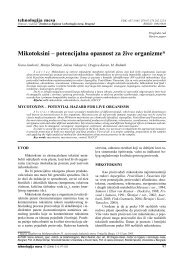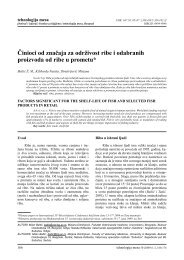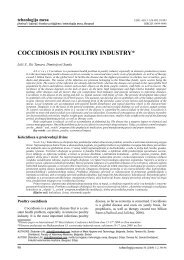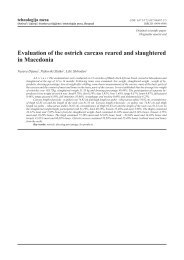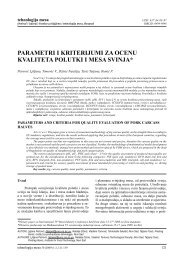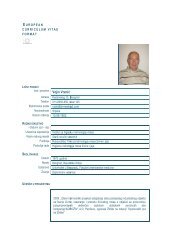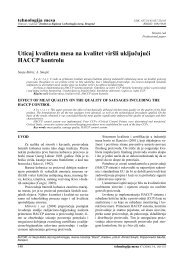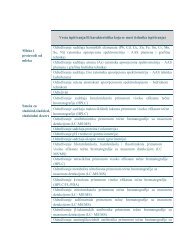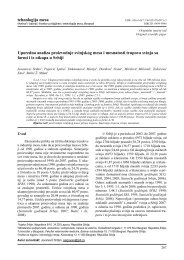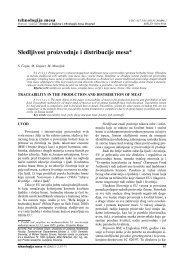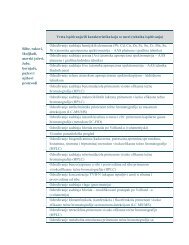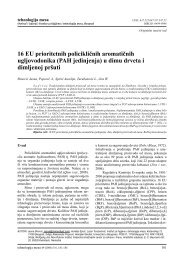Najnoviji broj Äasopisa - inmesbgd.com
Najnoviji broj Äasopisa - inmesbgd.com
Najnoviji broj Äasopisa - inmesbgd.com
You also want an ePaper? Increase the reach of your titles
YUMPU automatically turns print PDFs into web optimized ePapers that Google loves.
Tehnologija mesa 53 (2012) 2, 166–172<br />
Literatura<br />
Anonymous, 1898. “Oleum Cinnamomi (U.S.P.) – Oil of Cinnamon.”<br />
King’s American Dispensatory. http://www.ibiblio.org/herbmed/eclectic/kings/cinnamomum_oleu.html.<br />
Bagamboula C. F., Uyttendaele M., Debevere J., 2004. Inhibitory<br />
effect of thyme and basil essential oils, carvacrol,<br />
thymol, estragol, linalool and p-cymene towards Shigella<br />
sonnei and S. flexneri. Food Microbiology 21(1): 33–42.<br />
Becerril R., Gomez-Lus R., Goni P., Lopez P., Nerin C., 2007.<br />
Combination of analytical and microbiological techniques<br />
to study the antimicrobial activity of a new active<br />
food packaging containing cinnamon or oregano against<br />
E. coli and S. aureus. Analytical and Bioanalytical Chemistry<br />
388, 5, 1003–11.<br />
Davidson P. M., Zivanovic S., 2003. The use of natural antimicrobials.<br />
In: Zeuthen P, Bogh Sorensen L, editors. Food<br />
preservation techniques. Boca Raton, Fla.: Woodhead<br />
Publishing Limited and CRC Press LLC., 5–30.<br />
Friedman M., Henika P. R., Levin C. E., Mandrell R.E.,<br />
2004. Antibacterial activities of plant essentialoils and<br />
their <strong>com</strong>ponents against Escherichia coli O157:H7 and<br />
Salmonella enterica in apple juice. Journal of Agricultural<br />
and Food Chemistry 52, 19, 6042–8.<br />
Gutierrez J., Barry-Ryan C., Bourke P., 2009. Antimicrobial<br />
activity of plant essential oils using food model media:<br />
eficacy, synergistic potential and interactions with food<br />
<strong>com</strong>ponents. Food Microbiology 26, 2, 142–50.<br />
JECFA 2001. Safety evaluation of certain food additives and<br />
contaminants. WHO Food Additives Series No. 46, Genf.<br />
Johansen J. D., Andersen K. E., Rastogi S. C., Menne T.,<br />
1996. Threshold responses in cinnamic-aldehyde-sensitive<br />
subjects: results and methodological aspects. Contact<br />
Dermatitis. Mar, 34, 3, 165–71.<br />
Lambert R. J. W., Skandamis P. N., Coote P., Nychas G.<br />
J. E., 2001. A study of the minimum inhibitory concentration<br />
and mode of action of oregano essential oil, thymol<br />
and carvacrol. Journal of Applied Microbiology 91,<br />
453–462.<br />
Lin Y. T., Labbe R. G., Shetty K., 2004. Inhibition of Listeria<br />
monocytogenes in fish and meat systems by use of oregano<br />
and cranberry phytochemical synergies. Applied and<br />
Environmental Microbiology 70, 9, 5672–8.<br />
Lopez P., Sanchez C., Batlle R., Nerın C., 2007. Development<br />
of flexible antimicrobial film using essential oils as active<br />
agents. Journal of Agricultural and Food Chemistry,<br />
55, 21, 8814–24.<br />
Mereto E., Brambilla-Campart G., Ghia M., Martelli A.,<br />
Brambilla G., 1994. Cinnamaldehyde-induced micronuclei<br />
in rodent liver. Mutatio Research, 322, 1, 1–8.<br />
Radetić P., Milijašević M., Jovanović J., Velebit B., 2007. Pakovanje<br />
svežeg mesa u modifikovanoj atmosferi – trend<br />
koji traje! Međunarodno 54. savetovanje industrije mesa,<br />
Vrnjačka Banja, 2007. godine, Tehnologija mesa, 48, 1–2,<br />
99–108.<br />
Rodriguez-Lafuente A., Nerin C., Batlle R., 2010. Active<br />
paraffin-based paper packaging for extending the shelf<br />
life of cherry tomatoes. Journal of Agricultural and Food<br />
Chemistry 58, 11, 6780–6.<br />
Temesvári E., Németh I., Baló-Banga M. J., Husz S., Kohánka<br />
V., Somos Z., Judák R., Remenyik E. V., Szegedi A.,<br />
Nebenführer L., Mészáros C., Horváth A., 2002. Multicentre<br />
study of fragrance allergy in Hungary. Immediate<br />
and late type reactions. Contact Dermatitis, 46, 6, 325–30.<br />
Tepe B., Daferera D., Sokmen M., Polissiou M., Sokmen<br />
A., 2004. In vitro antimicrobial and antioxidant activities<br />
of the essential oils and various extracts of Thymus<br />
eigii. Journal of Agricultural and Food Chemistry, 52, 5,<br />
1132–7.<br />
Velebit B., Petrović Z. 2012. Antimikrobna pakovanja u industriji<br />
hrane. Tehnologija mesa, 51, 1, 71–79.<br />
Wendakoon C. N., Sakaguchi M., 1995. Inhibition of amino<br />
acid decarboxylase activity of Enterobacter aerogenes by<br />
active <strong>com</strong>ponents in spices. Journal of Food Protection,<br />
58, 3, 280–283.<br />
Study of antimicrobial activity of cinnamaldehyde and<br />
carvacrol against foodborne microorganisms<br />
Velebit Branko, Matekalo-Sverak Vesna, Petrović Zoran, Lakićević Brankica, Janković Vesna,<br />
Lilić Slobodan, Vranić Danijela<br />
S u m m a r y: Aim of the paper was to study antimicrobial activity of cinnamaldehyde and carvacrol at different concentrations<br />
on the panel of 12 selected and characteristic food pathogens and spoilage microorganisms. Cinnamaldehyde and carvacrol<br />
were diluted in a set of lipophilic and hydrophilic diluents down to concentrations of 0.5%, 1%, 2% and 3%, respectively. Suspensions<br />
of the test microorganisms were diluted down to 1 McFarland turbidometric unit and 0.1 mL of prepared inoculum was surface<br />
inoculated on tryptic soy agar. After absorption of inoculum, a nanofybrillic cellulose disc has been applied at the center of the each<br />
Petri dish and 32 μL of respective dilution of cinnamaldehyde and carvacrol was pipetted. After subsequent incubation, radius of<br />
inhibition zone for each tested microorganism had been measured. Results of the study indicated that the strongest inhibitory effect of<br />
cinnamaldehyde occurred in C. perfringens (5.29–20.60 mm), E. faecalis (8.28–19.40 mm) and L. sakei (4.80–11.10 mm) even at the<br />
lowest concentration (0.5%). S. cerevisiae proved to be absolutely resistant at all concentrations tested. Faecal Enterobacteriaceae<br />
contaminants (E. coli, E. coli O157:H7, P. mirabilis and S. Typhimurium) have also been quite inhibited, while the difference of E. coli<br />
inhibition zones (0,00–5.40 mm) <strong>com</strong>pared to those of S. Typhimurium (0.86–6.93 mm) were not statistically signifi cant (p = 0,910).<br />
171



